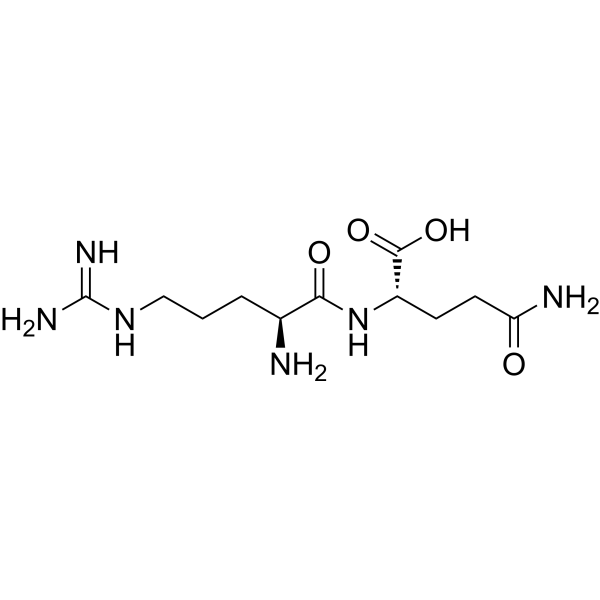2483-17-2
| Name | (2S)-5-amino-2-[[(2S)-2-amino-5-(diaminomethylideneamino)pentanoyl]amino]-5-oxopentanoic acid |
|---|---|
| Synonyms |
L-Arginyl-L-glutamin-acetat
Arginylglutamine Glutamine,N2-L-arginyl-(6CI,7CI) L-Arg-L-Gln L-Glutamine,N2-L-arginyl L-Glutamine,L-arginyl Glutamine,N2-L-arginyl-,L-(8CI) N2-L-Arginyl-L-glutamin N2-L-arginyl-L-glutamine L-Arginyl=>L-glutamin L-arginyl-L-glutamine H-ARG-GLN-OH |
| Description | Arginyl-Glutamine is a dipeptide that can decrease VEGF levels and inhibit retinal neovascularization in a mouse model of oxygen-induced retinopathy[1]. |
|---|---|
| Related Catalog | |
| Target |
VEGF[1] |
| In Vitro | Arginyl-Glutamine (0.5-1.5 mM; 48 h) 会导致人类 RPE 细胞中可溶性 VEGF 在培养基中的表达呈统计学意义上的剂量依赖性下降[1]。 |
| In Vivo | Arginyl-Glutamine (1-5 g/kg/day as a hydrochloride salt; i.p.; twice daily) 显著抑制小鼠氧诱导视网膜病变 (OIR) 模型中的视网膜新生血管[1]。 Animal Model: C57BL6/J mouse pups, oxygen-induced retinopathy (OIR) model[1] Dosage: 1.0, 2.5, or 5 g/kg per day Administration: Intraperitoneal injection, twice daily Result: Significantly decreased preretinal nuclei. Reduced neovascular tufts and vascular leakage in retinal vessels. Reduced preretinal neovascularization by 82% ± 7% and reduced VEGF mRNA by 64% ± 9% at 5 g/kg per day. |
| References |
| Molecular Formula | C11H22N6O4 |
|---|---|
| Molecular Weight | 302.33 |
| Exact Mass | 338.14700 |
| PSA | 197.41000 |
| LogP | 1.19630 |


